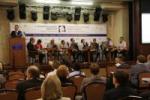- عربي
- Ukraine
- Economy
-
Investment
- Current Investment Trends
- Legal Conditions of Doing Business
- Investment Policy
- Competition
- Setting a Business in Ukraine
- Mergers and Acquisitions
- Taxation
- Import and Export
- Banks and Bank Regulation
- Convertibility and Profits Repatriation
- Currency Regulation
- Protection of Intellectual Property Rights
- Companies
- Travel to Ukraine
- About us
- Useful Sites
- Gallery
- News
Currency rates in UAH
| AED | ||
| BHD | ||
| EGP | ||
| KWD | ||
| LBP | ||
| OMR | ||
| QAR | ||
| SAR | ||
| SYP |
2015-07-06
| Kiev |  |
+32 |
| Donetsk |  |
+28 |
| Dnipropetrovsk |  |
+31 |
| Lviv |  |
+31 |
| Odessa |  |
+27 |
Economic History Note
Ukraine’s economy has historically been determined by such factors as its advantageous geographic location at the crossroads between Europe and Asia, an abundance of the most fertile topsoil called chornozem, a rich base of natural resources and a productive labor force. Metals and minerals like coal, iron ore, gas, stone, sand and salt are abundant in Ukraine. Ukraine has 40% of the world’s manganese ore, as well as the biggest deposits of ozocerite and sulfur in the world. The country also boasts the largest deposits of graphite in continental Europe.
When Ukraine proclaimed independence in August 1991, it had one of the highest indicators for gross national income and also per capita industrial and agricultural production in the former USSR. Ukraine once represented about 5% of global industrial output: 10% of its cast iron production, 9% of steel, and 8% of mined coal.
By the 1980s, however, the soviet-style economy began to show considerable unbalance, with an over-emphasis on heavy industries and machine building. More than 80% of industrial manufacturing did not have a closed production cycle, and output of consumer goods was extremely low.
From 1991-1994, Ukraine’s economy went into collapse. This transition period led to GDP plunging 40.4% as hyperinflation in 1993 reached a record-high 10,256%.
By 1994, the government began to define a strategy for economic reform and mechanisms to overcome the economy’s deep crisis. This stage led to lower inflation, macroeconomic stabilization and a halt in industrial decline. Direct foreign investments increased by 5.8 times in 1995–1998. A phase of economic stabilization and growth started in the first half of 1997, but was interrupted with the start of the Russian financial crisis in 1998. Growth slowly resumed in late 1999 with almost every economic indicator showing positive results. After an initial decade of decline, Ukraine’s GDP grew 33.1% over 2000–2003 and continued to grow 3-12% for five consecutive years.
Ukraine’s Economy, 2004-2012: Revolution, Crisis and Stagnation
After the Orange Revolution in 2004, Ukraine entered a 3-year period of economic growth. The election of President Yushchenko was positively assessed by the international investors, who brought over US $31 billion in foreign direct investment into Ukrainian economy. 2005-2008 were the years of rapid economic growth in banking, construction, telecoms, retail, processing and other sectors.
Economic growth and the availability of mortgage lending spurred a boom in the construction industry and real estate development that led to an unprecedented rise property prices across Ukraine. In 2008, the average price per sq m of residential space in Kyiv rose higher than US $3,800. Office estate also became among the most expensive in the world with average monthly rent for Class A premises over US $120 per sq m.
Despite many hopes, the democratic leaders of the Orange Revolution did not manage to agree on main goals or a strategy of economic development for the country. 2005-2009 became years of political uncertainty, which grew considerably as the global crisis reached Ukraine in Q3 of 2008. In 2008, Ukraine’s economic growth abruptly slowed to 2.1% y-o-y, pointing to a sharp contraction in Q4. By the end of 2008, the country’s currency had lost nearly 60% of its value to the US dollar. Depreciation and the deep economic downturn undermined the stability of the banking sector. Fortunately, monetary and government officials began to actively address the weaknesses in the country’s banking system.
In 2007 and 2008, output of domestic machine-building products increased. But because of the crisis, sales volumes amounted to only UAH 85.8 billion, or 70.5% of output in 2008. Nevertheless, in 2010 output resumed growing and rose in value to UAH 116.35 bn. Finally it rose to UAH 154.19 bn. in 2011.
Ukraine’s economy remains burdened by excessive regulation, corruption, and lack of law enforcement, and while the government has taken steps against corruption and SMEs have been largely privatized, much remains to be done to restructure and privatize key sectors such as energy and to create a market system for agricultural land. President Yanukovych chairs the Committee on Economic Reform, and in 2010 an economic reform plan was drawn up for 2010-2014. In December 2010, a comprehensive new Tax Code was passed by the Verkhovna Rada and signed into law, provoking major street protests in Kyiv.
In July 2010, following extended negotiations, the International Monetary Fund (IMF) approved a second loan package to Ukraine, after an earlier package negotiated in 2008 went off-track. The new 29-month $15.2 billion Stand-By Arrangement (SBA) is primarily conditional on adjusting fiscal and monetary policy, increasing the residential natural gas price, and instituting pension reform. The Fund allocated first two tranches, but postponed subsequent ones in 2011, due to Ukraine’s refusal to increase residential services (utility) rates. The disbursement was postponed until the Ukrainian Government meets its commitments to enact reforms. The World Bank has committed more than $5 billion to Ukraine since the country joined the Bank in 1992.
Ukraine’s Economy, 2013-2014
Ukraine has experienced a dramatic change in its political landscape over the last few months. As of May 25, 2014, the country ousted its old, corrupt President and his cronies, it has elected a new President by a landslide, and it has a pro-Western interim Government in place.
To reduce Ukraine’s public sector fiscal deficits, which had increased to about 6-7% of GDP in 2013, the new Government announced strong fiscal austerity measures shortly after being appointed in late February. Its fiscal consolidation plan includes cuts in government spending and staffing, as well as large increases in utility rates and taxes. Such measures should bring the budget deficit to 4.5% of GDP in 2014 and below 3% of GDP in 2016.
On March 21, Ukraine signed the political part of the Association Agreement with the EU and the new President has indicated that he will move forward with the full AA and cooperation with NATO.
At the end of March, Ukraine also reached an IMF staff-level agreement on a new two-year loan of US $14-18 billion. The IMF program will unlock financial assistance programs from other sources, and total financial support could reach US $27 billion over the next two years. This amount should fully cover Ukraine’s foreign liquidity shortages in 2014-2015.
When Ukraine proclaimed independence in August 1991, it had one of the highest indicators for gross national income and also per capita industrial and agricultural production in the former USSR. Ukraine once represented about 5% of global industrial output: 10% of its cast iron production, 9% of steel, and 8% of mined coal.
By the 1980s, however, the soviet-style economy began to show considerable unbalance, with an over-emphasis on heavy industries and machine building. More than 80% of industrial manufacturing did not have a closed production cycle, and output of consumer goods was extremely low.
From 1991-1994, Ukraine’s economy went into collapse. This transition period led to GDP plunging 40.4% as hyperinflation in 1993 reached a record-high 10,256%.
By 1994, the government began to define a strategy for economic reform and mechanisms to overcome the economy’s deep crisis. This stage led to lower inflation, macroeconomic stabilization and a halt in industrial decline. Direct foreign investments increased by 5.8 times in 1995–1998. A phase of economic stabilization and growth started in the first half of 1997, but was interrupted with the start of the Russian financial crisis in 1998. Growth slowly resumed in late 1999 with almost every economic indicator showing positive results. After an initial decade of decline, Ukraine’s GDP grew 33.1% over 2000–2003 and continued to grow 3-12% for five consecutive years.
Ukraine’s Economy, 2004-2012: Revolution, Crisis and Stagnation
After the Orange Revolution in 2004, Ukraine entered a 3-year period of economic growth. The election of President Yushchenko was positively assessed by the international investors, who brought over US $31 billion in foreign direct investment into Ukrainian economy. 2005-2008 were the years of rapid economic growth in banking, construction, telecoms, retail, processing and other sectors.
Economic growth and the availability of mortgage lending spurred a boom in the construction industry and real estate development that led to an unprecedented rise property prices across Ukraine. In 2008, the average price per sq m of residential space in Kyiv rose higher than US $3,800. Office estate also became among the most expensive in the world with average monthly rent for Class A premises over US $120 per sq m.
Despite many hopes, the democratic leaders of the Orange Revolution did not manage to agree on main goals or a strategy of economic development for the country. 2005-2009 became years of political uncertainty, which grew considerably as the global crisis reached Ukraine in Q3 of 2008. In 2008, Ukraine’s economic growth abruptly slowed to 2.1% y-o-y, pointing to a sharp contraction in Q4. By the end of 2008, the country’s currency had lost nearly 60% of its value to the US dollar. Depreciation and the deep economic downturn undermined the stability of the banking sector. Fortunately, monetary and government officials began to actively address the weaknesses in the country’s banking system.
In 2007 and 2008, output of domestic machine-building products increased. But because of the crisis, sales volumes amounted to only UAH 85.8 billion, or 70.5% of output in 2008. Nevertheless, in 2010 output resumed growing and rose in value to UAH 116.35 bn. Finally it rose to UAH 154.19 bn. in 2011.
Ukraine’s economy remains burdened by excessive regulation, corruption, and lack of law enforcement, and while the government has taken steps against corruption and SMEs have been largely privatized, much remains to be done to restructure and privatize key sectors such as energy and to create a market system for agricultural land. President Yanukovych chairs the Committee on Economic Reform, and in 2010 an economic reform plan was drawn up for 2010-2014. In December 2010, a comprehensive new Tax Code was passed by the Verkhovna Rada and signed into law, provoking major street protests in Kyiv.
In July 2010, following extended negotiations, the International Monetary Fund (IMF) approved a second loan package to Ukraine, after an earlier package negotiated in 2008 went off-track. The new 29-month $15.2 billion Stand-By Arrangement (SBA) is primarily conditional on adjusting fiscal and monetary policy, increasing the residential natural gas price, and instituting pension reform. The Fund allocated first two tranches, but postponed subsequent ones in 2011, due to Ukraine’s refusal to increase residential services (utility) rates. The disbursement was postponed until the Ukrainian Government meets its commitments to enact reforms. The World Bank has committed more than $5 billion to Ukraine since the country joined the Bank in 1992.
Ukraine’s Economy, 2013-2014
Ukraine has experienced a dramatic change in its political landscape over the last few months. As of May 25, 2014, the country ousted its old, corrupt President and his cronies, it has elected a new President by a landslide, and it has a pro-Western interim Government in place.
To reduce Ukraine’s public sector fiscal deficits, which had increased to about 6-7% of GDP in 2013, the new Government announced strong fiscal austerity measures shortly after being appointed in late February. Its fiscal consolidation plan includes cuts in government spending and staffing, as well as large increases in utility rates and taxes. Such measures should bring the budget deficit to 4.5% of GDP in 2014 and below 3% of GDP in 2016.
On March 21, Ukraine signed the political part of the Association Agreement with the EU and the new President has indicated that he will move forward with the full AA and cooperation with NATO.
At the end of March, Ukraine also reached an IMF staff-level agreement on a new two-year loan of US $14-18 billion. The IMF program will unlock financial assistance programs from other sources, and total financial support could reach US $27 billion over the next two years. This amount should fully cover Ukraine’s foreign liquidity shortages in 2014-2015.
Economic impact of Russian Invasion of Ukraine and conflict in Eastern Ukraine
Annexation of Crimea by Russia
The annexation caused by a military intervention of Russia into the Autonomous Republic of Crimea and the city of Sevastopol, both administrative divisions of Ukraine.
The main direct economic consequence of the Crimea annexation is the loss of the Black Sea gas fields and a possible deterioration in the country’s energy sector.
Resources in the northwestern part of the Black Sea shelf are estimated at 495.7 billion cubic meters of natural gas and 50.4 million tons of oil and condensate, in Kerch area - 321.2 billion cubic meters of gas and 126.8 million tons of oil and condensate, continental slope - 766.6 billion cubic meters of natural gas and 232 million tons of oil and condensate. The total gas potential of the Black Sea shelf is estimated at 2.3 billion tons of fuel. It is approximately 40% of total gas deposits in Ukraine. Though the industry requires large investments, the development of the Black Sea deposits was considered as an effective way to reduce dependence on gas supplies from Russia.
The direct economic losses will arise from the nationalization of Ukrainian enterprises located in Crimea. "Chornomornaftogas", "Ukrtransgas", a series of powerful chemical industry enterprises, ports and more than 130 resorts can be nationalized.
For most private companies, nationalization is quite a remote risk. Ukrainian owners of the Crimean assets can face the problem of re-registration. After the annexation of Crimea all private property, including land, real estate, and companies must be re-registered in accordance with Russian legislation. The need for reissuing of shareholders' registers will result in a sharp increase of transaction costs for medium and large businesses. Loss of Crimean seaports can lead to short-term losses for their major customers – grain exporters. A transport blockade of the peninsula will lead to cargo traffic leaving from the Crimean ports to terminals in Mykolaiv, Kherson and Azov ports.
Conflict in Eastern Ukraine
The economic blockade of pro-Russian separatists controlled regions came on top of enormous infrastructure damage as a result of the conflict with Ukraine. Ukrainian Minister of Finance announced in October 2014 that reconstruction of those parts of the Donbass currently under Ukraine's control would cost approximately $2 billion.
In Donetsk Oblast (region), industrial production has fallen by 59 percent over the past year, while an 85 percent drop was registered in Luhansk Oblast. Before the crisis, the two oblasts accounted for 20 percent of Ukrainian industrial production.
Most of the territories' industrial enterprises have shut down, including the Luhansk Machine-building Works, the Stirol fertilizer works, at least seven steelworks, the German-owned Heidelberg Cement works, etc. Out of the region's approximately 140 coal mines, 93 are on separatist-controlled territory, 69 of which have suspended operations. Over half of the labor force in the so-called “DPR” and “LPR” has neither employment nor any other source of income. 40,000 small businesses have declared bankruptcy. Food production has fallen by 25-30 percent. Thousands of kilometers of roads, 30 bridges, and 4585 apartment buildings have been destroyed. Fifty-eight thermoelectric power stations have been damaged. More than a hundred villages have been cut off from all electric power sources.
In July, 2014, Ministry of Energy and Coal Industry estimates losses of Ukrainian energy sector as a result of the annexation of Crimea by Russia as USD 300 billion.
Some of the economic chaos in Ukraine has spilled over to Russia and other European economies. The World Bank estimates that Russia’s economic growth will slow to 0.5 percent this year, nearly 2 percentage points lower than it would have been had Russia not annexed Crimea. On a continental scale, European growth will be reduced by about 1 percentage point because of trade linkages to Russia and Ukraine.
2015
Preliminary data show that Ukraine’s economy shrank in the first quarter of 2015 by 17.6% over the same period last year. The deterioration, which was worse than expected, was driven by the military conflict in the east of the country that has pushed Ukraine into a downward economic spiral. In addition, high-frequency indicators show no signs that the economy’s downward growth trajectory is going to halt as the contraction in industrial production worsened in April. As a result, both the scale and success of the IMF’s USD 17.5 billion bailout are now being called into question. It appears that the macroeconomic forecasts that the bailout was modelled upon are highly unlikely to come to fruition and it is unknown if the program will be expanded.
2016
After the crisis-torn economy contracted by almost 10% last year, the situation appears to be improving significantly in the first half of 2016. Fewer military clashes and exchange rate stability are contributing to the improvement in economic data, and the political crisis that has persisted since February appears to be resolved. In April, the Parliament approved Volodymyr Groysman as the new prime minister, thus ending months of political deadlock and paving the way for the government to turn its attention back to passing the reforms the IMF has demanded. Since Groysman and the new cabinet came into power, reform implementation has picked up pace and a new energy tariff system was passed at the end of April.




